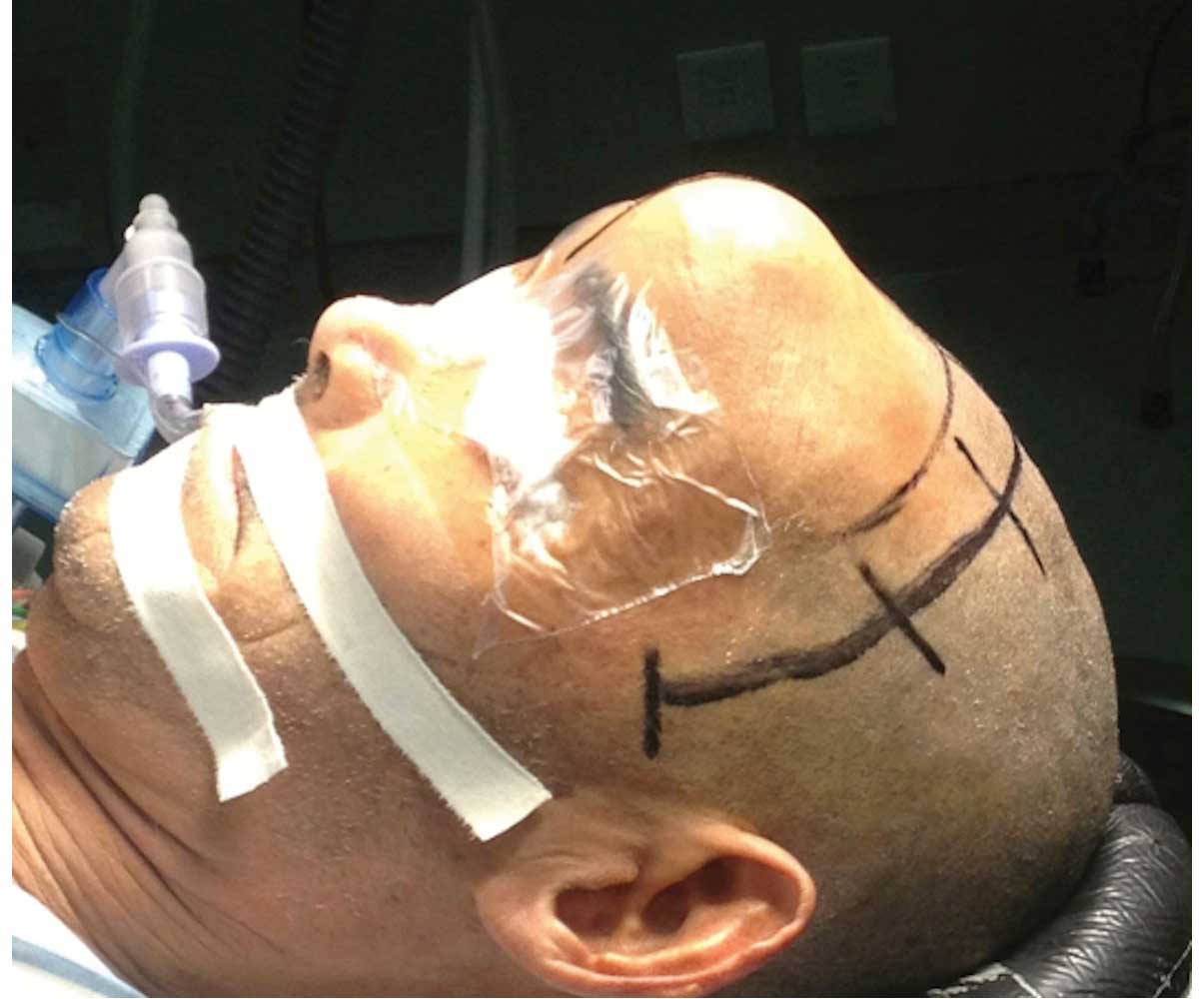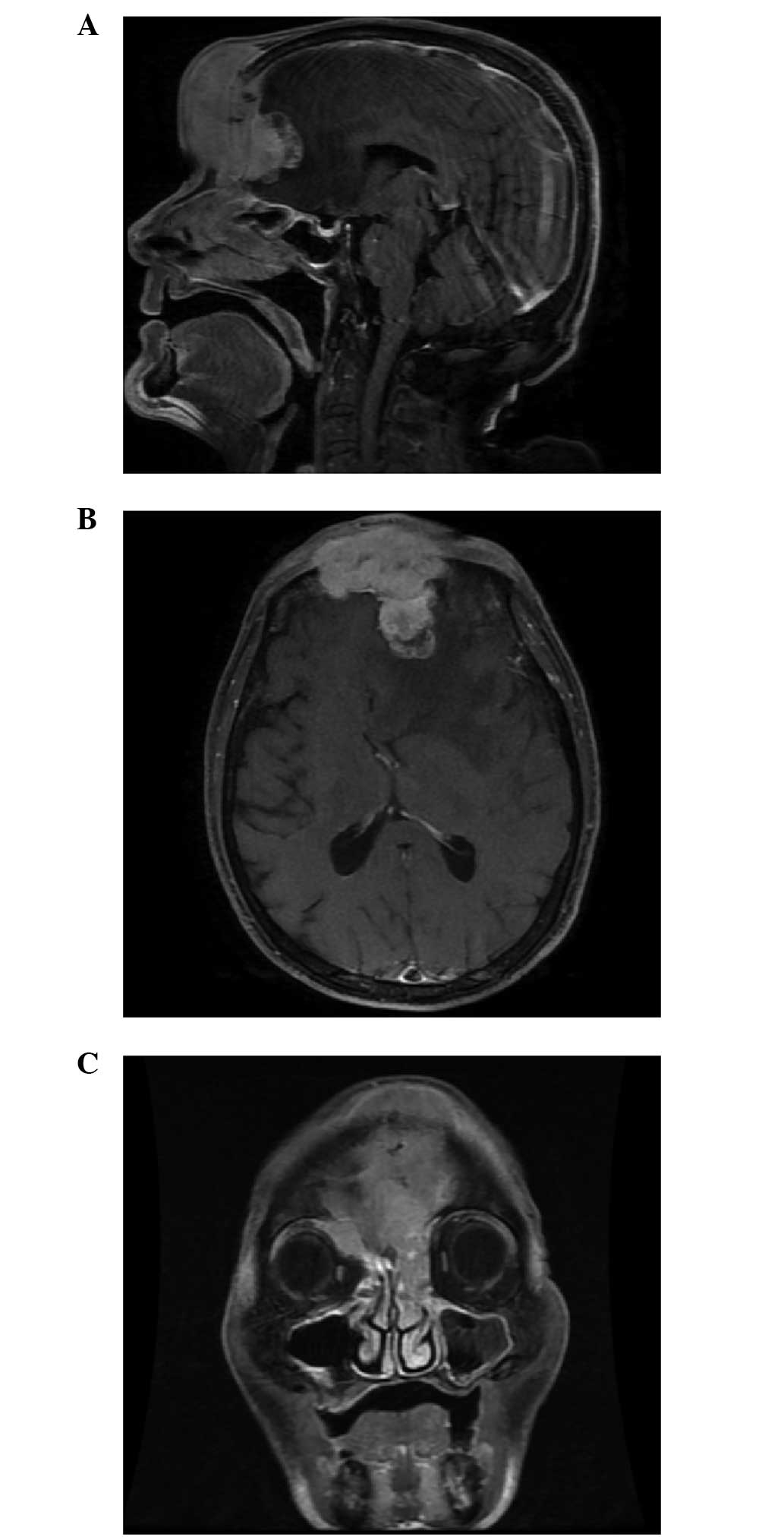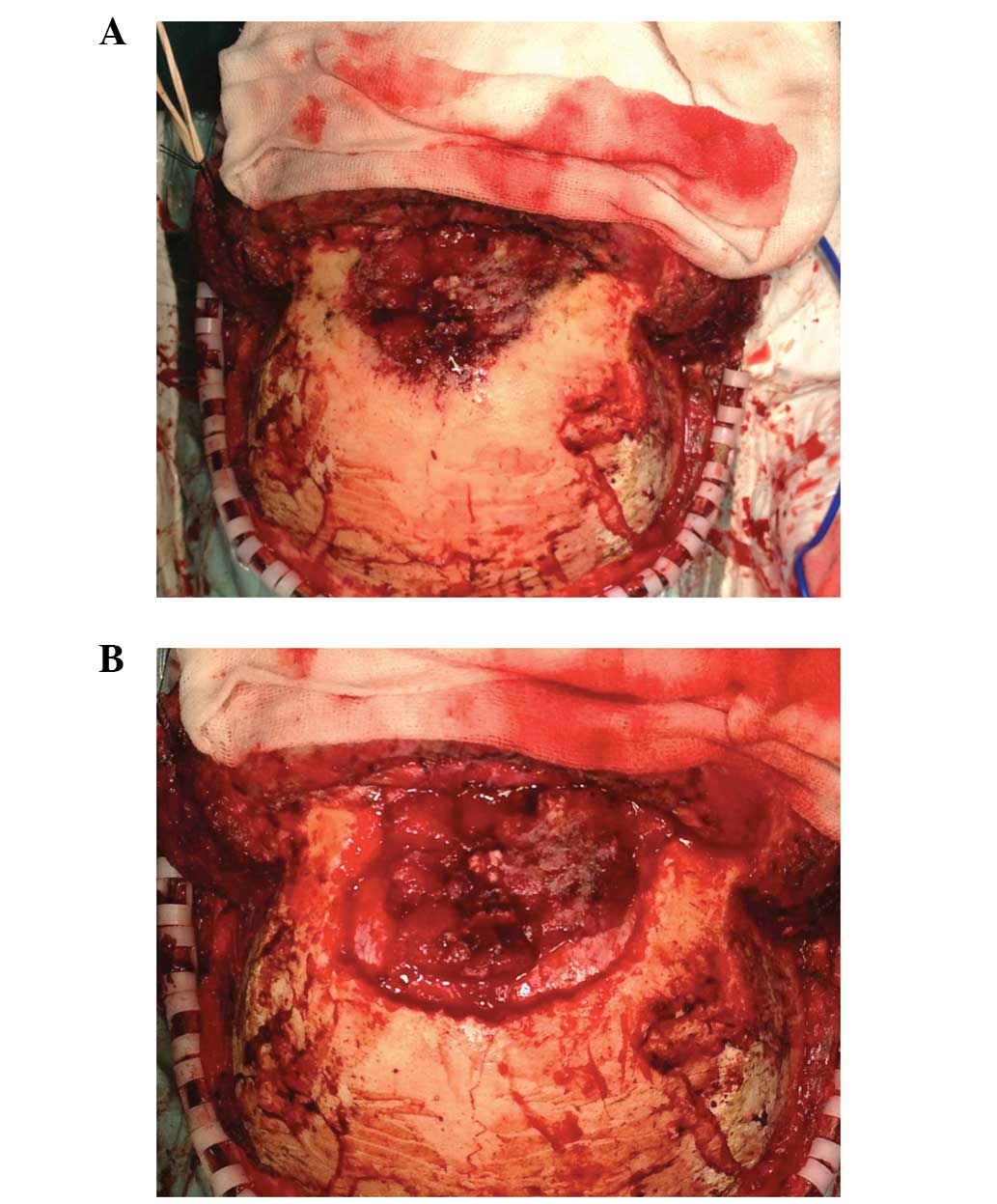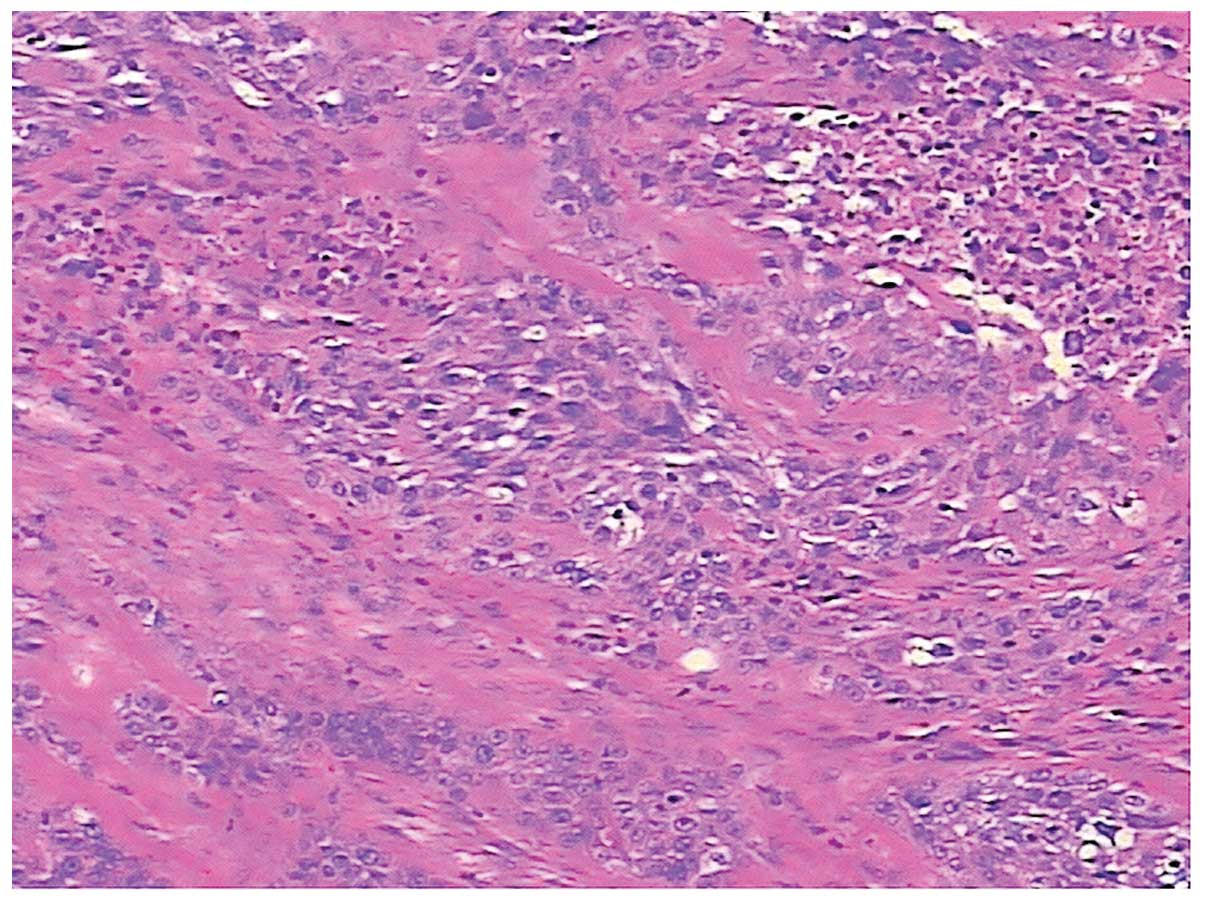Introduction
Primary carcinoma of the frontal sinus, accounting
for 0.3–1.0% of all paranasal sinus carcinomas, is extremely rare
(1,2). The tumor exhibits a high incidence in
older patients (>50 years old), with a male to female ratio of
5:1 (3). The symptoms of paranasal
sinus carcinoma are ambiguous and non-specific. This often makes it
difficult to diagnose these tumors at the early stage. The
histologically predominant type of frontal sinus cancer is squamous
cell carcinoma (SCC), which is present in 43–64% of cases (4). The present study reports a rare case
of SCC arising in the frontal sinus. A 66-year-old male presented
with a subcutaneous nodule and underwent a total resection. A large
solid tumor in the frontal sinus was detected following head
magnetic resonance imaging (MRI), and this tumor invaded into the
dura, frontal lobe, ethmoid sinus and orbit. The relevant
literature surrounding this disease is also reviewed in the present
study in order to raise the issue of the diagnosis, treatment and
prognosis of this disease. The study was approved by the Ethics
Committee of the Clinical Medical College of Yangzhou University
(Jiangsu, China) and informed consent was obtained from the
patient.
Case report
A 66-year-old male visited Yizheng People’s Hospital
(Yangzhou, China) due to a nodule on the left side of the forehead,
which was accompanied by orbital pain and occasional headaches that
had been apparent for 4 months. The patient was administered
several courses of antibiotics, however, these did not relieve the
symptoms. One month prior to the patient being admitted to the
Northern Jiangsu People’s Hospital (Yangzhou, Jiangsu, China) the
headaches became continuous and extremely severe in the left side
of the forehead over the frontal sinus region. The patient was
consequently transferred to the Department of Neurosurgery in
December 2012. A physical examination revealed a giant, solid and
low mobility ~4×6-cm subcutaneous nodule on the left side of the
forehead (Fig. 1). The patient
could not open the right eye fully due to the nodule. Computed
tomography (CT) and MRI of the head showed a large uneven
soft-tissue mass measuring 54×76 mm in the left frontal sinus, with
intracranial extension into areas that included the frontal lobe,
the anterior wall of the ethmoid sinus and the orbit. The signal of
the mass was hypointense on T1-weighted MRI images and hyperintense
on T2-weighted images. The lesion showed uniform homogenous
enhancement following gadolinium-contrast injection (Fig. 2). The patient had no family history
of sinus cancer, was not taking any medication, did not smoke and
did not drink alcohol. The erosion of the frontal bone gave rise to
the suspicion of malignant disease or a metastatic tumor.
A frontal craniotomy was performed with the aim of
removing the tumor in December 2012. Subsequent to opening a skin
flap, the tumor was found to invade through the frontal bone and to
extend to the left frontal lobe (Fig.
3A). The extra-cranial lesion was resected en bloc as widely as
possible and the erosion of the frontal bone was extended by
resection into the normal bones and dura, to remove a section 7×8
cm in diameter (Fig. 3B). During
the surgical procedure, the intra-cranial lesions invading the left
frontal lobe, ethmoid sinus, superior sagittal sinus and the wall
of the orbit were radically resected. The lesion in the ethmoid
sinus was coagulated by electrocauterization subsequent to an
extended resection. The frontal base was opened to the ethmoid
sinus and sphenoid sinus for drainage to the nasal cavity. The
defect of the dura was patched using a Neuro-Patch (DuraMax;
Beijing TianXinFu Medical Appliance Co., Ltd., Beijing, China). The
forehead and frontal skull base were reconstructed with a rectus
abdominis myocutaneous free flap.
Histopathological examination of a biopsy revealed a
proliferation of large round cells with abundant cytoplasm
(Fig. 4). The result of the
histopathological examination was a diagnosis of SCC. Given that
primary carcinomas of the frontal sinus are rare, the patient
underwent further investigations, including chest and abdominal CT
scans and a pelvic ultrasound. The results showed that there were
no other primary lesions in the other organs. The histological,
radiological and investigational results were all diagnostic of a
primary carcinoma of the frontal sinus. Four weeks after the
surgical procedure, radiotherapy (50 Gy in 15 fractions) was
performed. Six months after the surgery, the repeat MRI
examinations did not find evidence of recurrence or metastatic
lesions.
Discussion
The incidence of malignant tumors of the anterior
skull base appears to be high in the Asian population (5). In 1907, Prawssud (6) was the first to report cell carcinoma
of the frontal sinus, and in 1999 Huang (7) was the first to report a case of
primary carcinoma of the frontal sinus in China. Paranasal sinus
carcinomas present most commonly with nasal obstruction, nasal
bleeding, nasal discharge, anosmia, proptosis, diplopia, facial
pain, headache and oppressive sensation (8). These symptoms of frontal sinus cancers
have been mimicked with other lesions, including mucoceles,
pyoceles or osteomyelitis. In the study described by Robinson
(4), a unique frontal sinus cancer
presented with a form of frontal mucocele. Reddy et al
(9) also reported a case of frontal
sinus cancer mimicking acute frontal sinusitis. In the present
case, a patient who originally visited the local hospital’s
Department of Dermatology (Yizheng, China) was diagnosed with a
benign lesion until the CT scan showed a intracranial invasive
lesion. This highlights why these tumors are often only diagnosed
at an advanced stage.
An early diagnosis usually depends on the
characteristics found upon CT/MRI examination. The pattern of
frontal sinus cancers on MRI includes signal hypointensity on
T1-weighted images and hyperintensity on T2-weighted images, and
always showing homogeneous enhancement. Patients may benefit from
the evaluation of the precise extent of frontal sinus tumors, and
this may aid in planning the surgical approach and method of
skull-base reconstruction. The CT/MRI brain scan may aid in the
early detection of frontal sinus SCC, but not confirm it. The
pathological results of the resection specimen are required to
provide a definite diagnosis. Therefore, we suggest that the
criteria of the confirmative diagnosis of frontal sinus cancers is
as follows: i) The radiological result shows that the tumor
originates from the frontal sinus; ii) the histologically
predominant type of tumor sample is SCC, adenocarcinoma or basal
cell carcinoma; and iii) there is no positive finding in the
investigation of other organs, aiming to eliminate a metastatic
tumor. The present case showed a subcutaneous nodule with skin
symptoms, including pruritus, pain and numbness. It is important to
perform radiological examinations for such patients, aiming to find
lesions in the frontal sinus. The diagnosis of a malignant tumor in
the frontal sinus should also be considered when patients present
with several predictors in the CT/MRI scan, including intracranial
invasion, destruction of the anterior skull base and deep orbital
spread.
The treatment for frontal sinus tumors remains
controversial, and there are no uniform standard treatment
strategies. It is consequently difficult for surgeons to choose the
correct treatment for frontal sinus tumors due to their rarity and
the diversity of treatment. Therefore, conclusions can only be
drawn from a limited number of case studies. One previous study
revealed that radical resection may be of benefit by significantly
alleviating the symptoms and decreasing the recurrence rate
(10). A clinical trial reported by
Guntinas-Lichius et al (11)
described the modality and multimodality treatment of 229 patients
with malignant sinonasal cancers in a single institution. The study
indicated that radical surgery is the treatment of choice for stage
I-II tumors. Furthermore, it is also difficult to perform a total
excision of frontal sinus cancer due to the complicated anatomy of
the frontal sinus, particularly in those patients with wide
intracranial invasion. In the present case, the reason for the
difficulty in performing a total resection was as follows: i) Prior
to the surgery, the tumor had invaded the left frontal lobe,
ethmoid sinus, superior sagittal sinus and the wall of the orbit,
thereby greatly increasing the difficulty of surgical resection;
ii) during the surgery, the border of the nodules was larger than
previously observed by the surgeons, resulting in an inadequate
resection range; and iii) ethmoid skull base reconstruction was
difficult to perform following resection of the lesion. In the
present case, radical resection under frontal craniotomy was
performed followed by post-operative radiotherapy, and autologous
muscle slurry and biological glue were applied to repair the skull
base. There was no cerebrospinal fluid leakage and the follow-up
MRI imaging showed no recurrence at 6 months.
The adjuvant treatment for this condition is the
same as for conventional SCC. It is unclear whether the use of
chemotherapy and radiotherapy could improve the prognosis of
frontal SCC. The overall response to chemotherapy is ~82%, and
regimens based on cisplatin appear to be reasonably effective,
particularly in association with 5-fluorouracil and bleomycin
(12). A previous study (13) revealed that radiotherapy alone
proved ineffective in advanced paranasal sinus carcinomas. By
contrast, another study (14)
indicated that radiotherapy was helpful in local control.
Therefore, analysis of the long-term effects of radiotherapy or
chemotherapy by further clinical trials is required to clarify this
issue. Currently, the combination of chemotherapy and radiotherapy
is considered to be the favored choice. The severe side-effects
from radiotherapy, including possible optic nerve damage and
radionecrosis, should be taken into consideration. Individual
treatment depends on the condition of the patient, therefore,
appropriate treatment strategies should be chosen with caution.
With regard to the prognostic situation, previous
studies have shown a poor prognosis for this advanced tumor. In
1969, Frew (15) reported 6 cases
of frontal sinus cancer, and the average survival duration was only
14 months. Yoshida et al (8)
reported the case of a 74-year-old male with frontal sinus cancer.
Although this patient underwent total resection followed by
radiotherapy (50 Gy), the tumor recurred three months after surgery
and the patient succumbed 20 months after surgery due to a
tumor-associated reason. In China there have only been two case
reports of frontal sinus cancer. Huang (7) reported the case of a patient who
underwent surgical treatment followed by radiotherapy and
chemotherapy. The tumor recurred three months after surgery and the
patient succumbed seven months after the surgery due to
intracranial metastasis and infection. A study by Wang et al
(16) reported three cases of
frontal sinus SCC; one presented with recurrence along the incision
six months after surgery and succumbed 16 months post-operatively,
while another tumor recurred in the frontal sinus and orbit 40 days
after the surgery and the patient succumbed 10 months after the
surgery. The third tumor recurred 14 months after surgery. The
study considered that survival with the tumor can be a choice for
patients who refuse radical surgical intervention. Despite the
performance of radical resection followed by post-operative
radiotherapy or chemotherapy, the prognosis of patients with stage
III-IV frontal sinus tumors remains extremely poor.
Frontal sinus tumors can easily be mistaken for
certain benign lesions, including mucoceles, pyoceles or
osteomyelitis. CT/MRI scans are necessary for the early detection
of frontal sinus lesions and to aid in the evaluation of the
precise extent of the tumors. The present case illustrates the fact
that neurosurgeons should try to increase the accuracy of the early
diagnosis of suspicious cases using CT/MRI scans, which can aid in
the selection of an appropriate therapy. Surgeons should clarify
the border of the lesion prior to surgery, and perform the extended
resection based on these findings. Therefore, the use of a complete
resection with a clear margin and adjuvant therapy is an essential
strategy for the treatment of such a malignant tumor.
Acknowledgements
The authors wish to express their gratitude to Dr
Guangyu Lu from Ruprecht-Karls-Universität Heidelberg, Germany, for
providing editorial assistance.
Abbreviations:
|
CT
|
computed tomography
|
|
MRI
|
magnetic resonance imaging
|
|
SCC
|
squamous cell carcinoma
|
References
|
1
|
Vrionis FD, Kienstra MA, Rivera M and
Padhya TA: Malignant tumors of the anterior skull base. Cancer
Control. 11:144–151. 2004.PubMed/NCBI
|
|
2
|
Gerlinger I, Gobel G, Tóth E, Szanyi I and
Weninger C: Primary carcinoma of the frontal sinus: a case report
and a review of literature. Eur Arch Otorhinolaryngol. 265:593–597.
2008. View Article : Google Scholar : PubMed/NCBI
|
|
3
|
Brownson RJ and Ogura JH: Primary
carcinoma of the frontal sinus. Laryngoscope. 81:71–89. 1971.
View Article : Google Scholar : PubMed/NCBI
|
|
4
|
Robinson JM: Frontal sinus cancer
manifests as a frontal mucocele. Arch Otolaryngol. 101:718–721.
1975. View Article : Google Scholar
|
|
5
|
Ichinose T, Goto T, Motomura H, Terakawa Y
and Ohata K: Primary squamous cell carcinoma of the frontal sinus
treated with en bloc resection: case report. Neuro Med Chir
(Tokyo). 49:481–483. 2009. View Article : Google Scholar : PubMed/NCBI
|
|
6
|
Prawssud NG: Carcinoma sinus frontalis.
Vestnik Oftalmologii. 24:253–255. 1907.
|
|
7
|
Huang F: A case of primary frontal sinus
carcinoma. Zhong Guo Zhong Liu Lin Chuang Za Zhi. 3:2341999.(In
Chinese).
|
|
8
|
Yoshida N, Kanekura T, Hashiguchi T, et
al: Primary squamous cell carcinoma of the frontal sinus. J
Dermatol. 33:855–857. 2006. View Article : Google Scholar : PubMed/NCBI
|
|
9
|
Reddy MS, Gihooly M, Wallace M and Ali MH:
Frontal sinus carcinoma presenting as acute sinusitis. J Laryngol
Otol. 105:121–122. 1991. View Article : Google Scholar : PubMed/NCBI
|
|
10
|
Kapur YP and Fairman HD: A case of
carcinoma of the frontal sinus. J Laryngol Otol. 72:995–1000. 1958.
View Article : Google Scholar
|
|
11
|
Guntinas-Lichius O, Kreppel MP, Stuetzer
H, et al: Single modality and multimodality treatment of nasal and
paranasal sinuses cancer: a single institution experience of 229
patients. Eur J Surg Oncol. 33:222–228. 2007. View Article : Google Scholar
|
|
12
|
LoRusso P, Tapazoglou E, Kish JA, et al:
Chemotherapy for paranasal sinus carcinoma. A 10-year experience at
Wayne State University. Cancer. 62:1–5. 1988.PubMed/NCBI
|
|
13
|
Dirix P, Nuyts S, Geussens Y, et al:
Malignancies of the nasal cavity and paranasal sinuses: long-term
outcome with conventional or three-dimensional conformal
radiotherapy. Int J Radiat Oncol Biol Phys. 69:1042–1050. 2007.
View Article : Google Scholar
|
|
14
|
Rischin D, Porceddu S, Peters L, et al:
Promising results with chemoradiation in patients with sinonasal
undifferentiated carcinoma. Head Neck. 26:435–441. 2004. View Article : Google Scholar : PubMed/NCBI
|
|
15
|
Frew I: Frontal sinus carcinoma. J
Laryngol Otol. 83:393–396. 1969. View Article : Google Scholar
|
|
16
|
Wang RG, Wang G and Chen L: Three cases of
primary squamous cell carcinoma in the frontal sinus. Zhonghua Er
Bi Yan Hou Tou Jing Wai Ke Za Zhi. 46:664–668. 2011.(In
Chinese).
|


















